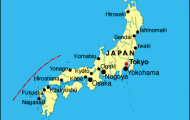Getting on a gigantic cruise ship and spending a few weeks going from island to island in the Caribbean is not a new idea. There is, however, one major island that was always left off the schedule for US cruise ships. Cuba and the US had a number of decades when they weren’t exactly best buddies.
This has changed, and while the two countries are not BFFs, they once again have formal diplomatic relations. This has opened up a whole new destination for US cruise ships, and 2016 will see the first US cruise ship to dock in Cuba for almost 50 years.
So when it comes to arriving in Cuba via ship, or even visiting the parts of Cuba that can only be reached on a ship, what do you need to know about seeing Cuba by water?
Arriving in Cuba by Ship
While it’s a very big step for US cruise ships to be once again setting sail for Cuba, non US ships have been cruising to the island for many years. This means that there is already a dedicated dock for large ships in Havana, with smaller docks in other cities. This is not a luxury cruise terminal, and you might find the facilities to be a little bit basic. Having said that, it’s not as though you want to spend a huge amount of time at the terminal, and it just exists to get you on and off the boat as quickly as possible.
The terminal is called Sierra Maestra, and it’s right next to Havana’s glorious Old Town. You can in fact walk to the Old Town from the terminal, and O’Reilly (one of the main streets) is about a 5 minute walk. Depending on how many bags you have with you and where in the Old Town you’re heading to, you might want to take one of the many waiting taxis, but beware of drivers who try to charge you an inflated flat rate for the journey. It’s really not that far!
Sailing Towards Youth
Even if you don’t arrive by ship there are some things to do in Cuba that require a boat trip. Until 1978, Cuba’s second largest island (after the main island itself) was named the Isla de Pinos (Isle of Pines), which is kind of logical since there are some magnificent pine forests in the area. Fidel Castro renamed the island as the Isla de la Juventud, and Cuba’s former leader had a personal reason to do so.
The island was home to one of the largest prisons in Cuba, and Castro spent two years in jail here in the 1950s, before he led the successful revolution against President Batista. The prison (known as Presidio Modelo) was closed down in 1967 and is now largely abandoned, although guided tours are available. The Isla de la Juventud is a fascinating slice of Cuban history, and is a part of the country that many people don’t get to see. This is a shame, since it’s utterly lovely while being very different from the rest of the country.
There is a ferry service which will make the journey from the mainland in about six hours. It’s a very slow boat, but is a fun way to travel if you’re not in the rush. There are also faster ferry services which are more expensive, but can get there in around three hours.
Pure Isolation, Pure Beauty
For a totally different island experience in Cuba, you need to visit the Jardines de la Reina (Gardens of the Queen), a group of islands located off the coast of Cuba’s Camag¼ey province.
The islands can be reached via a boat from the town of Santa Cruz del Sur, but there are services from other parts of the Camag¼ey province. The whole group of islands (which stretches for more than 150 km/93 miles along Cuba’s southern coast) is a national park, although fishing is permitted in some parts. If you don’t want to catch the fish, you can at least spend some time with the sea creatures here.
Diving is a popular pastime and there are a number of gigantic whale sharks who call these waters home. If you can find a boat with onboard accommodation, this is certainly your best bet. The most populated island in the Jardines is called Cayos Ana Maria and only ten people actually live here so accommodation options in this part of Cuba are hard to find! It’s stunningly beautiful here, and it feels so isolated in the most wonderful way.












